An In-Depth Analysis of Sport Organization Theory within AGPC
VerifiedAdded on 2021/05/31
|18
|4334
|33
Report
AI Summary
This report provides a critical analysis of the Australian Grand Prix Corporation (AGPC), examining power dynamics, political landscapes, organizational culture, and decision-making processes. It delves into the sources of individual power within the AGPC, including legitimate, expert, and referent power, and explores the influence of consultants and governing bodies. The report assesses the political environment, highlighting the AGPC's relationship with the Minister for Tourism and Major Events. It also investigates conflicts within the organization, specifically concerning the development of the Albert Park circuit, and discusses strategies for conflict management. Furthermore, the report analyzes the decision-making processes, considering different models and organizational culture, and concludes with recommendations for improvement and implications for future events.
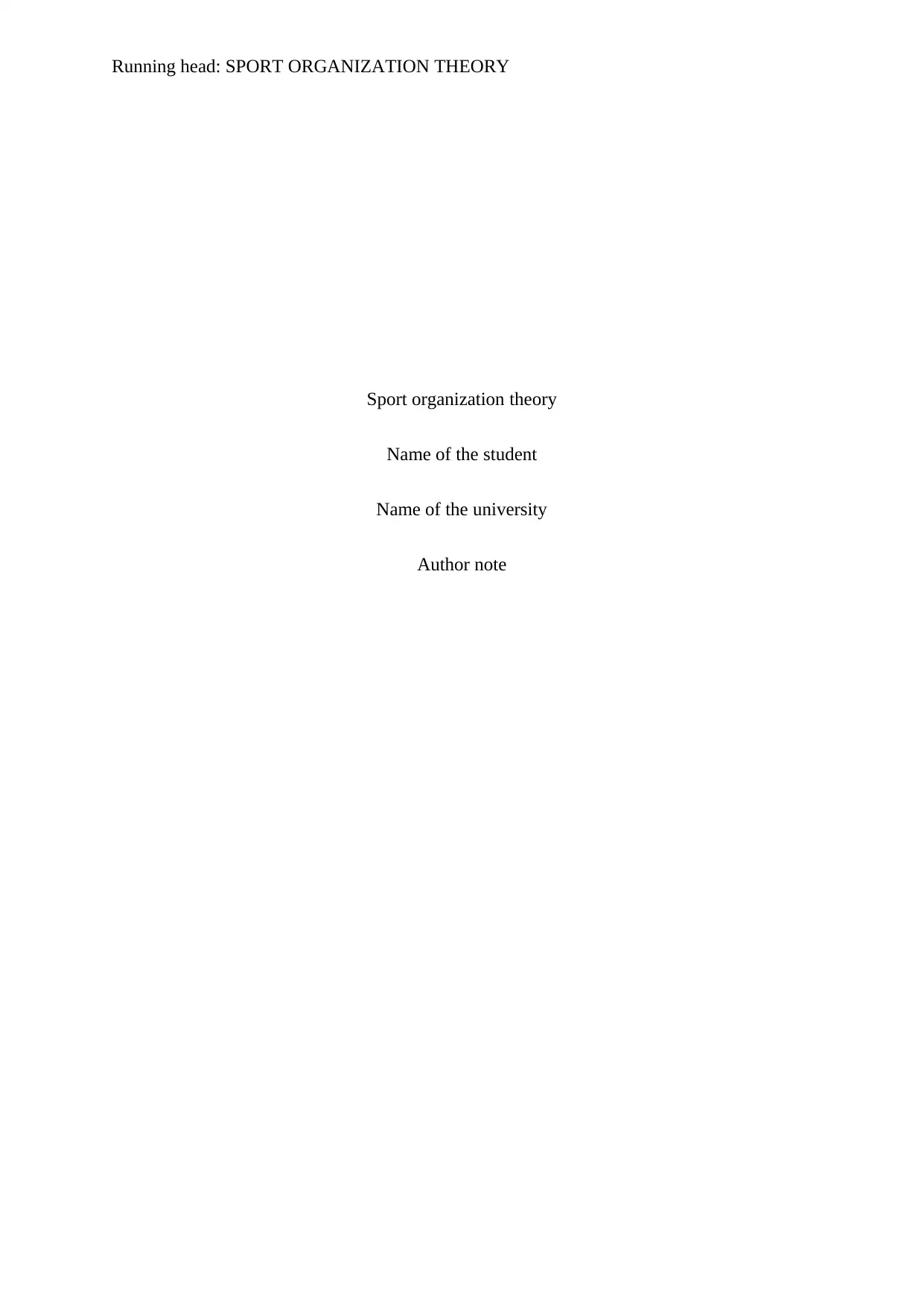
Running head: SPORT ORGANIZATION THEORY
Sport organization theory
Name of the student
Name of the university
Author note
Sport organization theory
Name of the student
Name of the university
Author note
Paraphrase This Document
Need a fresh take? Get an instant paraphrase of this document with our AI Paraphraser
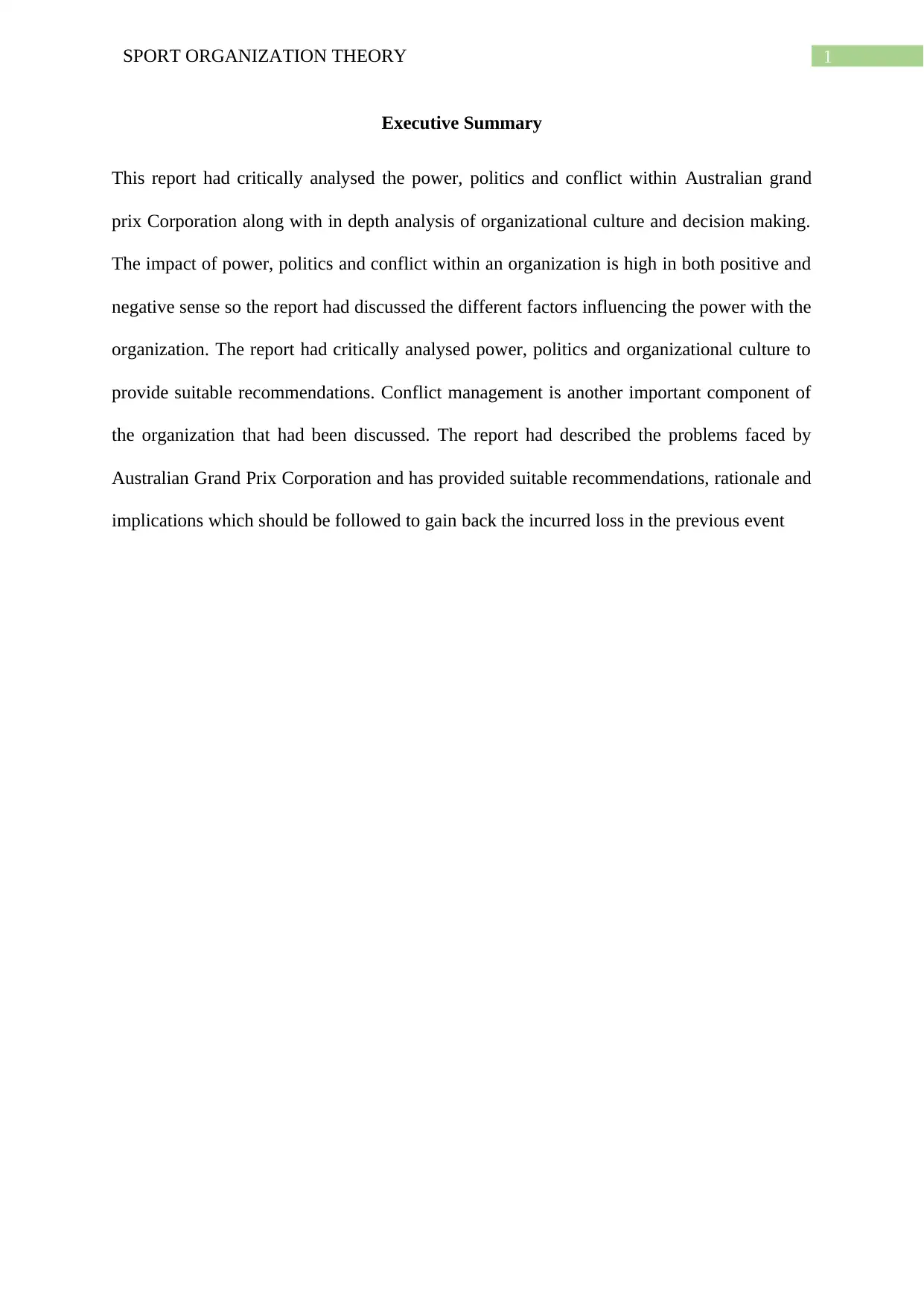
1SPORT ORGANIZATION THEORY
Executive Summary
This report had critically analysed the power, politics and conflict within Australian grand
prix Corporation along with in depth analysis of organizational culture and decision making.
The impact of power, politics and conflict within an organization is high in both positive and
negative sense so the report had discussed the different factors influencing the power with the
organization. The report had critically analysed power, politics and organizational culture to
provide suitable recommendations. Conflict management is another important component of
the organization that had been discussed. The report had described the problems faced by
Australian Grand Prix Corporation and has provided suitable recommendations, rationale and
implications which should be followed to gain back the incurred loss in the previous event
Executive Summary
This report had critically analysed the power, politics and conflict within Australian grand
prix Corporation along with in depth analysis of organizational culture and decision making.
The impact of power, politics and conflict within an organization is high in both positive and
negative sense so the report had discussed the different factors influencing the power with the
organization. The report had critically analysed power, politics and organizational culture to
provide suitable recommendations. Conflict management is another important component of
the organization that had been discussed. The report had described the problems faced by
Australian Grand Prix Corporation and has provided suitable recommendations, rationale and
implications which should be followed to gain back the incurred loss in the previous event
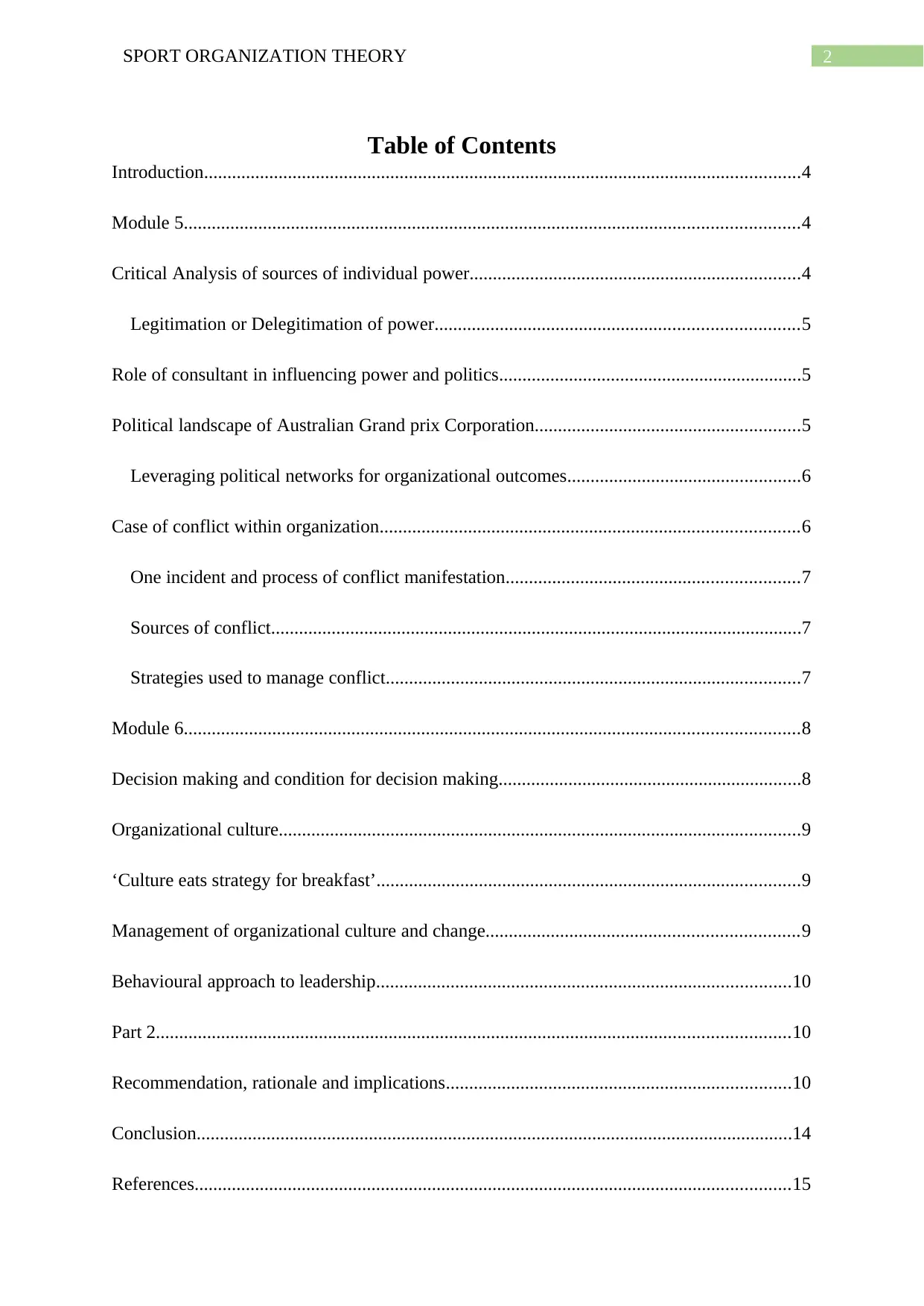
2SPORT ORGANIZATION THEORY
Table of Contents
Introduction................................................................................................................................4
Module 5....................................................................................................................................4
Critical Analysis of sources of individual power.......................................................................4
Legitimation or Delegitimation of power..............................................................................5
Role of consultant in influencing power and politics.................................................................5
Political landscape of Australian Grand prix Corporation.........................................................5
Leveraging political networks for organizational outcomes..................................................6
Case of conflict within organization..........................................................................................6
One incident and process of conflict manifestation...............................................................7
Sources of conflict..................................................................................................................7
Strategies used to manage conflict.........................................................................................7
Module 6....................................................................................................................................8
Decision making and condition for decision making.................................................................8
Organizational culture................................................................................................................9
‘Culture eats strategy for breakfast’...........................................................................................9
Management of organizational culture and change...................................................................9
Behavioural approach to leadership.........................................................................................10
Part 2........................................................................................................................................10
Recommendation, rationale and implications..........................................................................10
Conclusion................................................................................................................................14
References................................................................................................................................15
Table of Contents
Introduction................................................................................................................................4
Module 5....................................................................................................................................4
Critical Analysis of sources of individual power.......................................................................4
Legitimation or Delegitimation of power..............................................................................5
Role of consultant in influencing power and politics.................................................................5
Political landscape of Australian Grand prix Corporation.........................................................5
Leveraging political networks for organizational outcomes..................................................6
Case of conflict within organization..........................................................................................6
One incident and process of conflict manifestation...............................................................7
Sources of conflict..................................................................................................................7
Strategies used to manage conflict.........................................................................................7
Module 6....................................................................................................................................8
Decision making and condition for decision making.................................................................8
Organizational culture................................................................................................................9
‘Culture eats strategy for breakfast’...........................................................................................9
Management of organizational culture and change...................................................................9
Behavioural approach to leadership.........................................................................................10
Part 2........................................................................................................................................10
Recommendation, rationale and implications..........................................................................10
Conclusion................................................................................................................................14
References................................................................................................................................15
⊘ This is a preview!⊘
Do you want full access?
Subscribe today to unlock all pages.

Trusted by 1+ million students worldwide

3SPORT ORGANIZATION THEORY
Paraphrase This Document
Need a fresh take? Get an instant paraphrase of this document with our AI Paraphraser
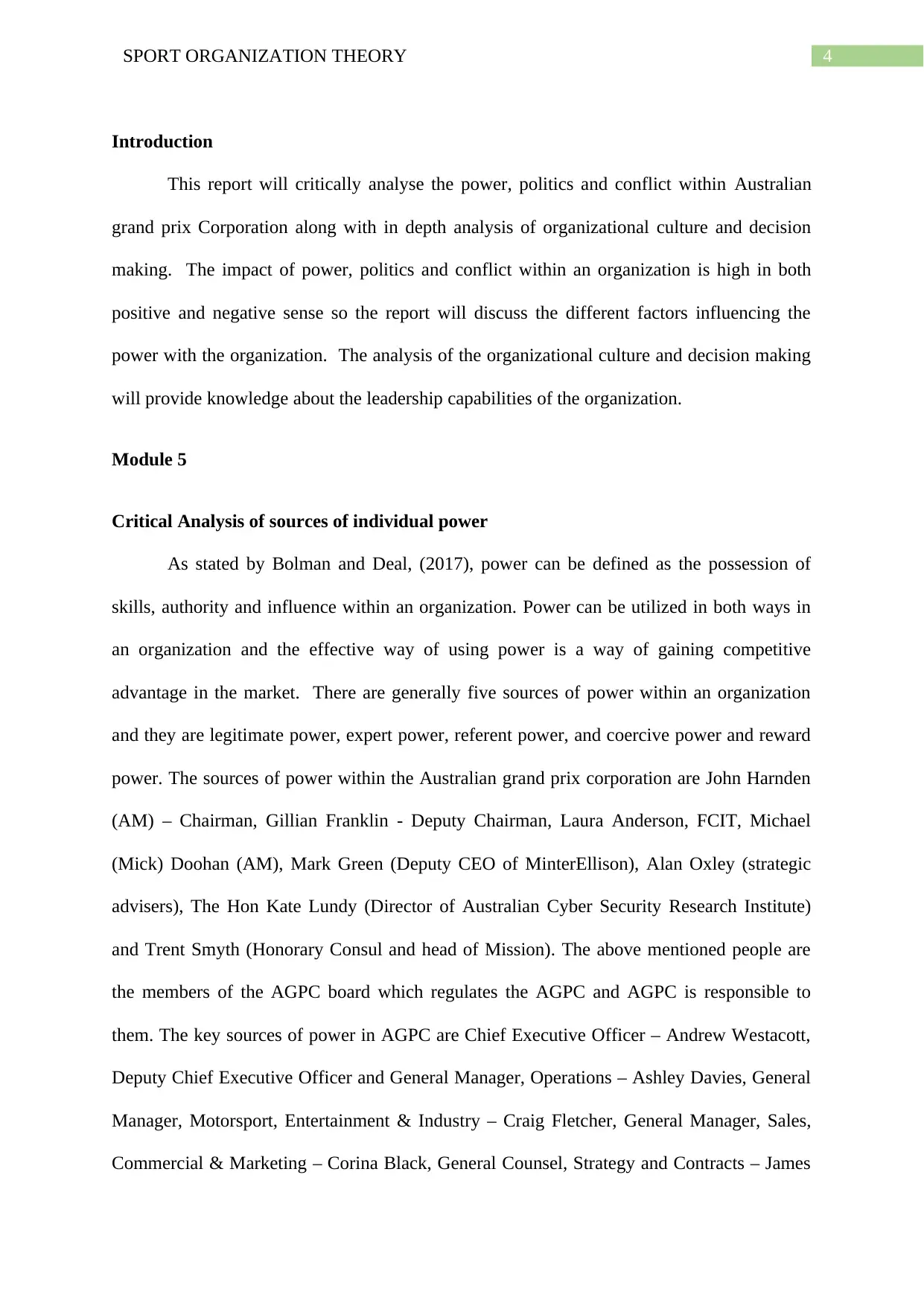
4SPORT ORGANIZATION THEORY
Introduction
This report will critically analyse the power, politics and conflict within Australian
grand prix Corporation along with in depth analysis of organizational culture and decision
making. The impact of power, politics and conflict within an organization is high in both
positive and negative sense so the report will discuss the different factors influencing the
power with the organization. The analysis of the organizational culture and decision making
will provide knowledge about the leadership capabilities of the organization.
Module 5
Critical Analysis of sources of individual power
As stated by Bolman and Deal, (2017), power can be defined as the possession of
skills, authority and influence within an organization. Power can be utilized in both ways in
an organization and the effective way of using power is a way of gaining competitive
advantage in the market. There are generally five sources of power within an organization
and they are legitimate power, expert power, referent power, and coercive power and reward
power. The sources of power within the Australian grand prix corporation are John Harnden
(AM) – Chairman, Gillian Franklin - Deputy Chairman, Laura Anderson, FCIT, Michael
(Mick) Doohan (AM), Mark Green (Deputy CEO of MinterEllison), Alan Oxley (strategic
advisers), The Hon Kate Lundy (Director of Australian Cyber Security Research Institute)
and Trent Smyth (Honorary Consul and head of Mission). The above mentioned people are
the members of the AGPC board which regulates the AGPC and AGPC is responsible to
them. The key sources of power in AGPC are Chief Executive Officer – Andrew Westacott,
Deputy Chief Executive Officer and General Manager, Operations – Ashley Davies, General
Manager, Motorsport, Entertainment & Industry – Craig Fletcher, General Manager, Sales,
Commercial & Marketing – Corina Black, General Counsel, Strategy and Contracts – James
Introduction
This report will critically analyse the power, politics and conflict within Australian
grand prix Corporation along with in depth analysis of organizational culture and decision
making. The impact of power, politics and conflict within an organization is high in both
positive and negative sense so the report will discuss the different factors influencing the
power with the organization. The analysis of the organizational culture and decision making
will provide knowledge about the leadership capabilities of the organization.
Module 5
Critical Analysis of sources of individual power
As stated by Bolman and Deal, (2017), power can be defined as the possession of
skills, authority and influence within an organization. Power can be utilized in both ways in
an organization and the effective way of using power is a way of gaining competitive
advantage in the market. There are generally five sources of power within an organization
and they are legitimate power, expert power, referent power, and coercive power and reward
power. The sources of power within the Australian grand prix corporation are John Harnden
(AM) – Chairman, Gillian Franklin - Deputy Chairman, Laura Anderson, FCIT, Michael
(Mick) Doohan (AM), Mark Green (Deputy CEO of MinterEllison), Alan Oxley (strategic
advisers), The Hon Kate Lundy (Director of Australian Cyber Security Research Institute)
and Trent Smyth (Honorary Consul and head of Mission). The above mentioned people are
the members of the AGPC board which regulates the AGPC and AGPC is responsible to
them. The key sources of power in AGPC are Chief Executive Officer – Andrew Westacott,
Deputy Chief Executive Officer and General Manager, Operations – Ashley Davies, General
Manager, Motorsport, Entertainment & Industry – Craig Fletcher, General Manager, Sales,
Commercial & Marketing – Corina Black, General Counsel, Strategy and Contracts – James
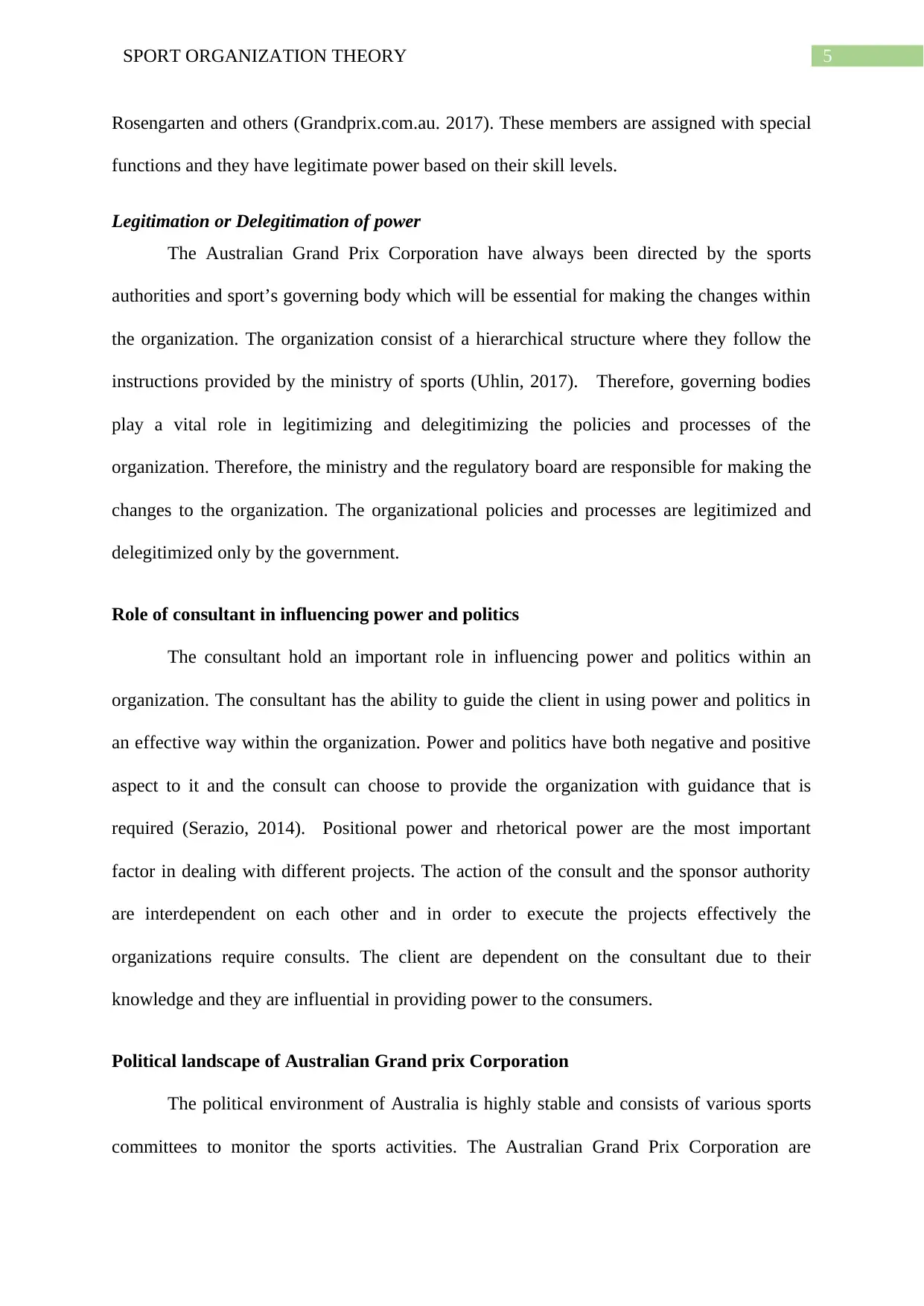
5SPORT ORGANIZATION THEORY
Rosengarten and others (Grandprix.com.au. 2017). These members are assigned with special
functions and they have legitimate power based on their skill levels.
Legitimation or Delegitimation of power
The Australian Grand Prix Corporation have always been directed by the sports
authorities and sport’s governing body which will be essential for making the changes within
the organization. The organization consist of a hierarchical structure where they follow the
instructions provided by the ministry of sports (Uhlin, 2017). Therefore, governing bodies
play a vital role in legitimizing and delegitimizing the policies and processes of the
organization. Therefore, the ministry and the regulatory board are responsible for making the
changes to the organization. The organizational policies and processes are legitimized and
delegitimized only by the government.
Role of consultant in influencing power and politics
The consultant hold an important role in influencing power and politics within an
organization. The consultant has the ability to guide the client in using power and politics in
an effective way within the organization. Power and politics have both negative and positive
aspect to it and the consult can choose to provide the organization with guidance that is
required (Serazio, 2014). Positional power and rhetorical power are the most important
factor in dealing with different projects. The action of the consult and the sponsor authority
are interdependent on each other and in order to execute the projects effectively the
organizations require consults. The client are dependent on the consultant due to their
knowledge and they are influential in providing power to the consumers.
Political landscape of Australian Grand prix Corporation
The political environment of Australia is highly stable and consists of various sports
committees to monitor the sports activities. The Australian Grand Prix Corporation are
Rosengarten and others (Grandprix.com.au. 2017). These members are assigned with special
functions and they have legitimate power based on their skill levels.
Legitimation or Delegitimation of power
The Australian Grand Prix Corporation have always been directed by the sports
authorities and sport’s governing body which will be essential for making the changes within
the organization. The organization consist of a hierarchical structure where they follow the
instructions provided by the ministry of sports (Uhlin, 2017). Therefore, governing bodies
play a vital role in legitimizing and delegitimizing the policies and processes of the
organization. Therefore, the ministry and the regulatory board are responsible for making the
changes to the organization. The organizational policies and processes are legitimized and
delegitimized only by the government.
Role of consultant in influencing power and politics
The consultant hold an important role in influencing power and politics within an
organization. The consultant has the ability to guide the client in using power and politics in
an effective way within the organization. Power and politics have both negative and positive
aspect to it and the consult can choose to provide the organization with guidance that is
required (Serazio, 2014). Positional power and rhetorical power are the most important
factor in dealing with different projects. The action of the consult and the sponsor authority
are interdependent on each other and in order to execute the projects effectively the
organizations require consults. The client are dependent on the consultant due to their
knowledge and they are influential in providing power to the consumers.
Political landscape of Australian Grand prix Corporation
The political environment of Australia is highly stable and consists of various sports
committees to monitor the sports activities. The Australian Grand Prix Corporation are
⊘ This is a preview!⊘
Do you want full access?
Subscribe today to unlock all pages.

Trusted by 1+ million students worldwide
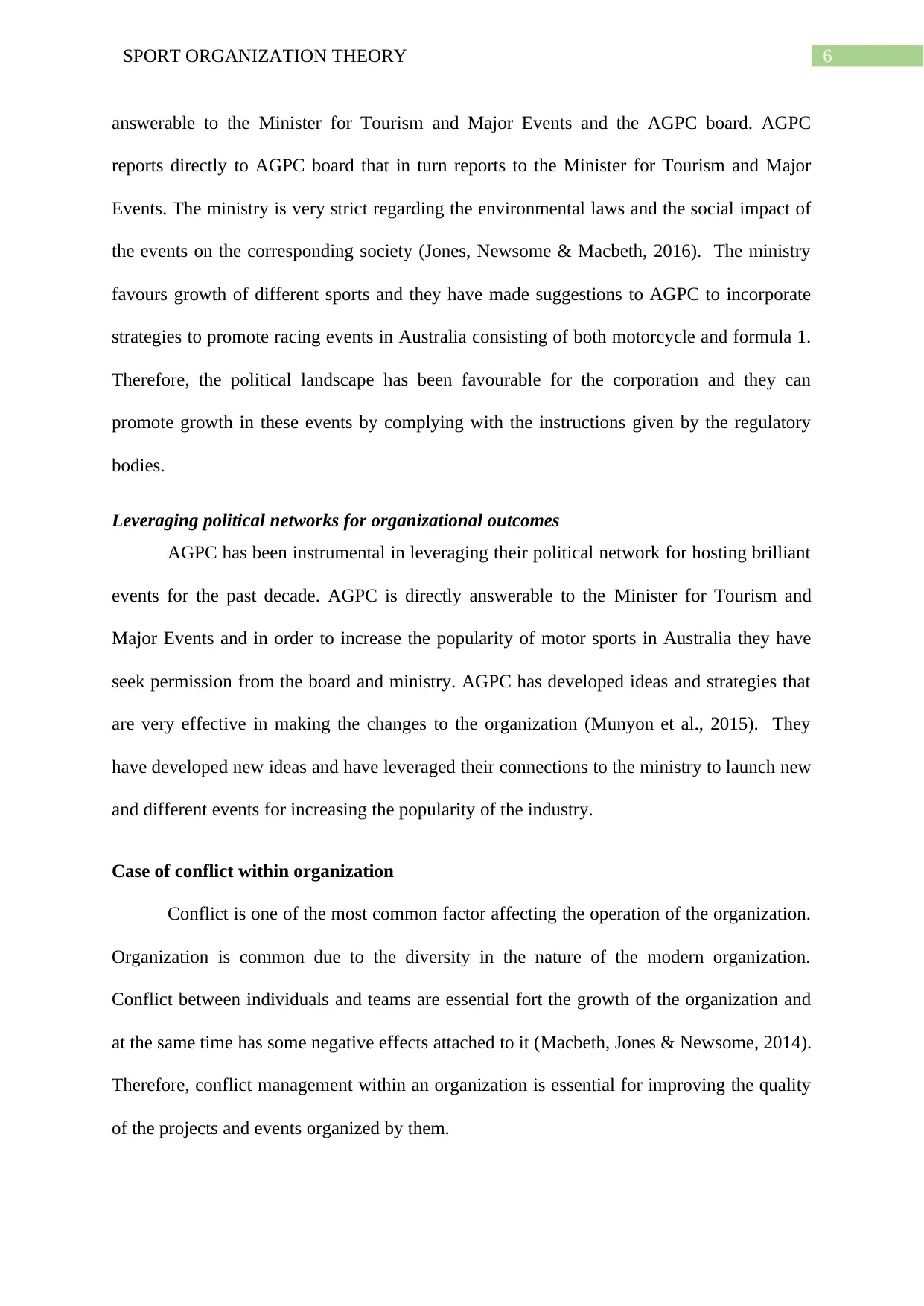
6SPORT ORGANIZATION THEORY
answerable to the Minister for Tourism and Major Events and the AGPC board. AGPC
reports directly to AGPC board that in turn reports to the Minister for Tourism and Major
Events. The ministry is very strict regarding the environmental laws and the social impact of
the events on the corresponding society (Jones, Newsome & Macbeth, 2016). The ministry
favours growth of different sports and they have made suggestions to AGPC to incorporate
strategies to promote racing events in Australia consisting of both motorcycle and formula 1.
Therefore, the political landscape has been favourable for the corporation and they can
promote growth in these events by complying with the instructions given by the regulatory
bodies.
Leveraging political networks for organizational outcomes
AGPC has been instrumental in leveraging their political network for hosting brilliant
events for the past decade. AGPC is directly answerable to the Minister for Tourism and
Major Events and in order to increase the popularity of motor sports in Australia they have
seek permission from the board and ministry. AGPC has developed ideas and strategies that
are very effective in making the changes to the organization (Munyon et al., 2015). They
have developed new ideas and have leveraged their connections to the ministry to launch new
and different events for increasing the popularity of the industry.
Case of conflict within organization
Conflict is one of the most common factor affecting the operation of the organization.
Organization is common due to the diversity in the nature of the modern organization.
Conflict between individuals and teams are essential fort the growth of the organization and
at the same time has some negative effects attached to it (Macbeth, Jones & Newsome, 2014).
Therefore, conflict management within an organization is essential for improving the quality
of the projects and events organized by them.
answerable to the Minister for Tourism and Major Events and the AGPC board. AGPC
reports directly to AGPC board that in turn reports to the Minister for Tourism and Major
Events. The ministry is very strict regarding the environmental laws and the social impact of
the events on the corresponding society (Jones, Newsome & Macbeth, 2016). The ministry
favours growth of different sports and they have made suggestions to AGPC to incorporate
strategies to promote racing events in Australia consisting of both motorcycle and formula 1.
Therefore, the political landscape has been favourable for the corporation and they can
promote growth in these events by complying with the instructions given by the regulatory
bodies.
Leveraging political networks for organizational outcomes
AGPC has been instrumental in leveraging their political network for hosting brilliant
events for the past decade. AGPC is directly answerable to the Minister for Tourism and
Major Events and in order to increase the popularity of motor sports in Australia they have
seek permission from the board and ministry. AGPC has developed ideas and strategies that
are very effective in making the changes to the organization (Munyon et al., 2015). They
have developed new ideas and have leveraged their connections to the ministry to launch new
and different events for increasing the popularity of the industry.
Case of conflict within organization
Conflict is one of the most common factor affecting the operation of the organization.
Organization is common due to the diversity in the nature of the modern organization.
Conflict between individuals and teams are essential fort the growth of the organization and
at the same time has some negative effects attached to it (Macbeth, Jones & Newsome, 2014).
Therefore, conflict management within an organization is essential for improving the quality
of the projects and events organized by them.
Paraphrase This Document
Need a fresh take? Get an instant paraphrase of this document with our AI Paraphraser
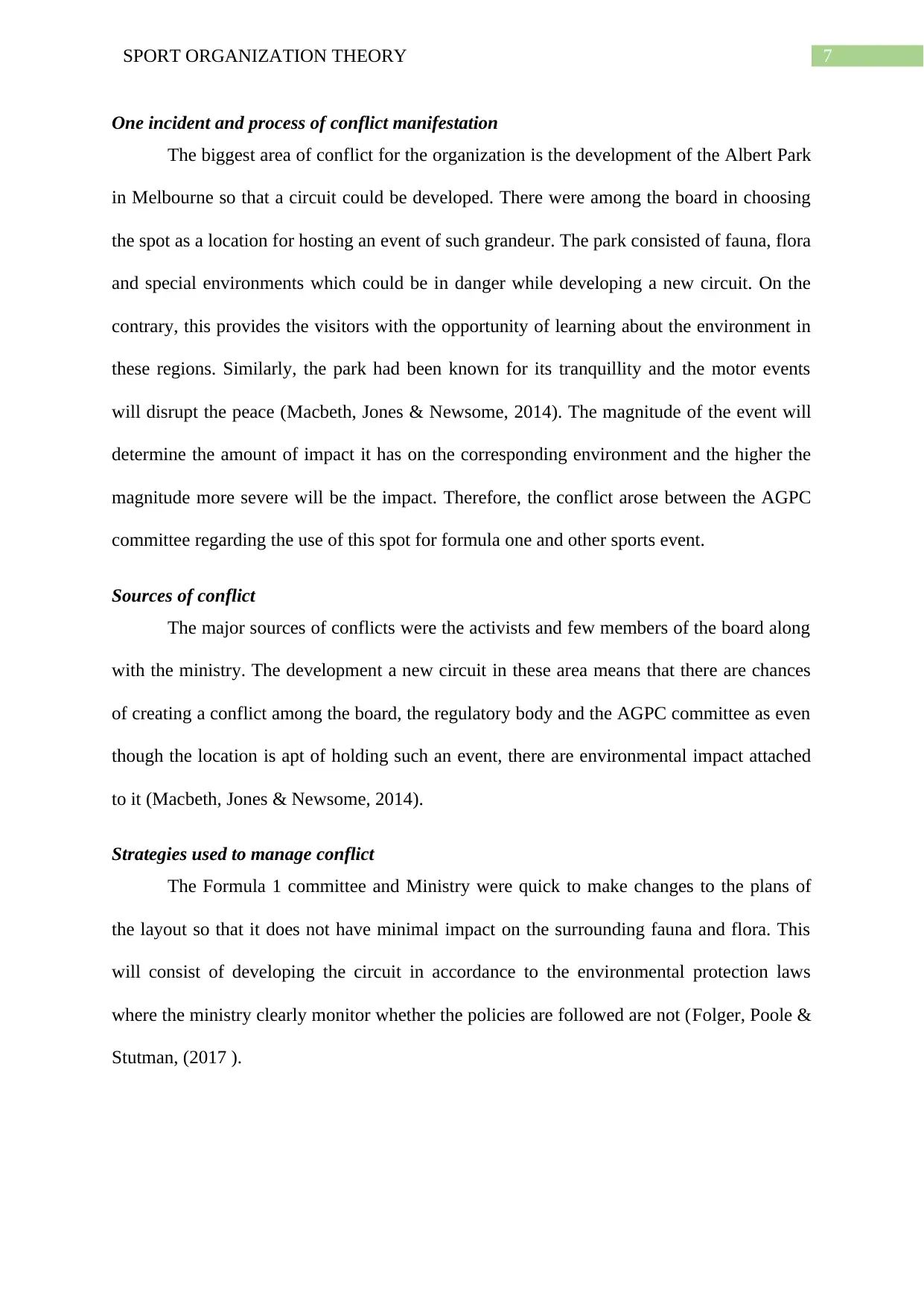
7SPORT ORGANIZATION THEORY
One incident and process of conflict manifestation
The biggest area of conflict for the organization is the development of the Albert Park
in Melbourne so that a circuit could be developed. There were among the board in choosing
the spot as a location for hosting an event of such grandeur. The park consisted of fauna, flora
and special environments which could be in danger while developing a new circuit. On the
contrary, this provides the visitors with the opportunity of learning about the environment in
these regions. Similarly, the park had been known for its tranquillity and the motor events
will disrupt the peace (Macbeth, Jones & Newsome, 2014). The magnitude of the event will
determine the amount of impact it has on the corresponding environment and the higher the
magnitude more severe will be the impact. Therefore, the conflict arose between the AGPC
committee regarding the use of this spot for formula one and other sports event.
Sources of conflict
The major sources of conflicts were the activists and few members of the board along
with the ministry. The development a new circuit in these area means that there are chances
of creating a conflict among the board, the regulatory body and the AGPC committee as even
though the location is apt of holding such an event, there are environmental impact attached
to it (Macbeth, Jones & Newsome, 2014).
Strategies used to manage conflict
The Formula 1 committee and Ministry were quick to make changes to the plans of
the layout so that it does not have minimal impact on the surrounding fauna and flora. This
will consist of developing the circuit in accordance to the environmental protection laws
where the ministry clearly monitor whether the policies are followed are not (Folger, Poole &
Stutman, (2017 ).
One incident and process of conflict manifestation
The biggest area of conflict for the organization is the development of the Albert Park
in Melbourne so that a circuit could be developed. There were among the board in choosing
the spot as a location for hosting an event of such grandeur. The park consisted of fauna, flora
and special environments which could be in danger while developing a new circuit. On the
contrary, this provides the visitors with the opportunity of learning about the environment in
these regions. Similarly, the park had been known for its tranquillity and the motor events
will disrupt the peace (Macbeth, Jones & Newsome, 2014). The magnitude of the event will
determine the amount of impact it has on the corresponding environment and the higher the
magnitude more severe will be the impact. Therefore, the conflict arose between the AGPC
committee regarding the use of this spot for formula one and other sports event.
Sources of conflict
The major sources of conflicts were the activists and few members of the board along
with the ministry. The development a new circuit in these area means that there are chances
of creating a conflict among the board, the regulatory body and the AGPC committee as even
though the location is apt of holding such an event, there are environmental impact attached
to it (Macbeth, Jones & Newsome, 2014).
Strategies used to manage conflict
The Formula 1 committee and Ministry were quick to make changes to the plans of
the layout so that it does not have minimal impact on the surrounding fauna and flora. This
will consist of developing the circuit in accordance to the environmental protection laws
where the ministry clearly monitor whether the policies are followed are not (Folger, Poole &
Stutman, (2017 ).
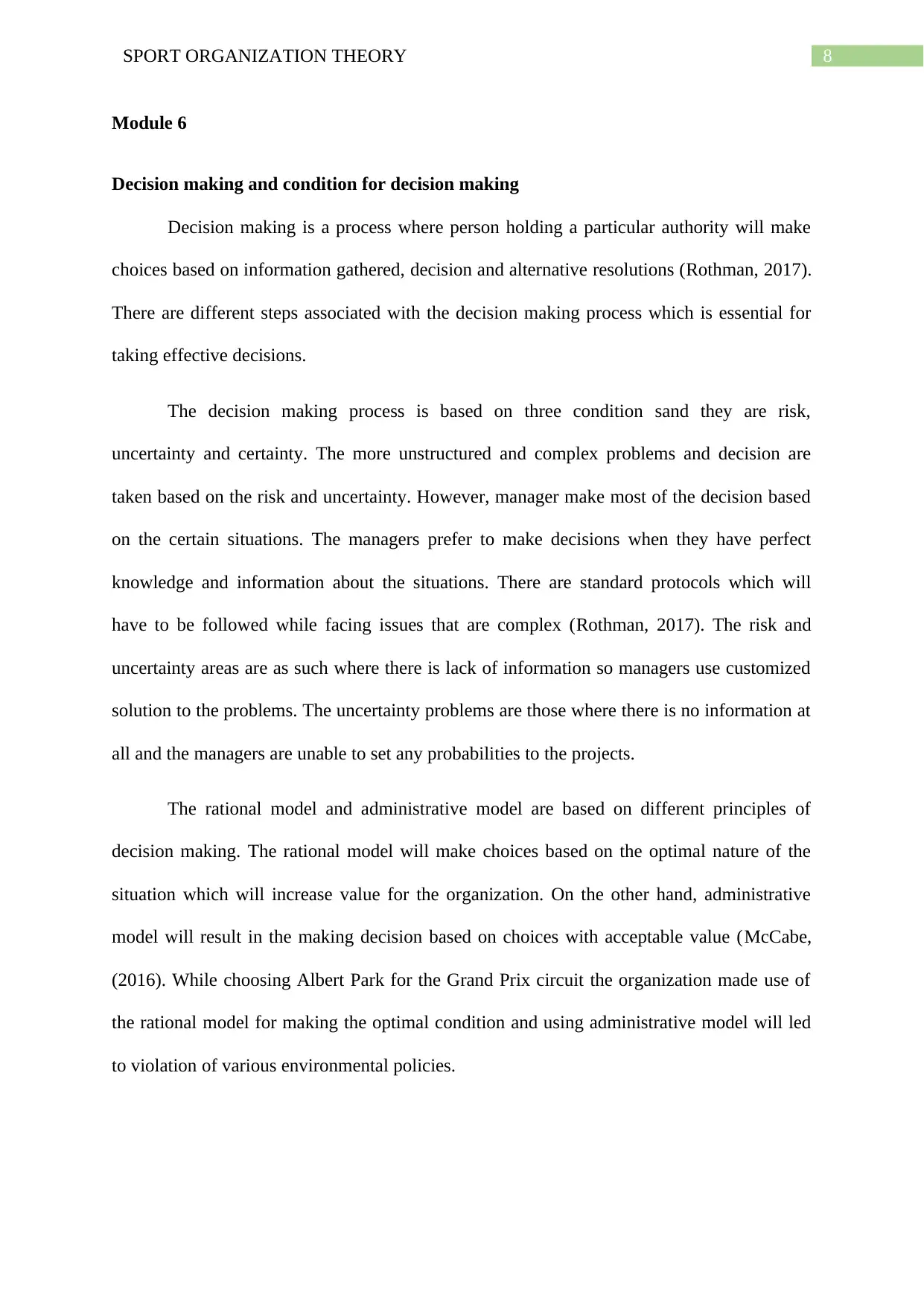
8SPORT ORGANIZATION THEORY
Module 6
Decision making and condition for decision making
Decision making is a process where person holding a particular authority will make
choices based on information gathered, decision and alternative resolutions (Rothman, 2017).
There are different steps associated with the decision making process which is essential for
taking effective decisions.
The decision making process is based on three condition sand they are risk,
uncertainty and certainty. The more unstructured and complex problems and decision are
taken based on the risk and uncertainty. However, manager make most of the decision based
on the certain situations. The managers prefer to make decisions when they have perfect
knowledge and information about the situations. There are standard protocols which will
have to be followed while facing issues that are complex (Rothman, 2017). The risk and
uncertainty areas are as such where there is lack of information so managers use customized
solution to the problems. The uncertainty problems are those where there is no information at
all and the managers are unable to set any probabilities to the projects.
The rational model and administrative model are based on different principles of
decision making. The rational model will make choices based on the optimal nature of the
situation which will increase value for the organization. On the other hand, administrative
model will result in the making decision based on choices with acceptable value (McCabe,
(2016). While choosing Albert Park for the Grand Prix circuit the organization made use of
the rational model for making the optimal condition and using administrative model will led
to violation of various environmental policies.
Module 6
Decision making and condition for decision making
Decision making is a process where person holding a particular authority will make
choices based on information gathered, decision and alternative resolutions (Rothman, 2017).
There are different steps associated with the decision making process which is essential for
taking effective decisions.
The decision making process is based on three condition sand they are risk,
uncertainty and certainty. The more unstructured and complex problems and decision are
taken based on the risk and uncertainty. However, manager make most of the decision based
on the certain situations. The managers prefer to make decisions when they have perfect
knowledge and information about the situations. There are standard protocols which will
have to be followed while facing issues that are complex (Rothman, 2017). The risk and
uncertainty areas are as such where there is lack of information so managers use customized
solution to the problems. The uncertainty problems are those where there is no information at
all and the managers are unable to set any probabilities to the projects.
The rational model and administrative model are based on different principles of
decision making. The rational model will make choices based on the optimal nature of the
situation which will increase value for the organization. On the other hand, administrative
model will result in the making decision based on choices with acceptable value (McCabe,
(2016). While choosing Albert Park for the Grand Prix circuit the organization made use of
the rational model for making the optimal condition and using administrative model will led
to violation of various environmental policies.
⊘ This is a preview!⊘
Do you want full access?
Subscribe today to unlock all pages.

Trusted by 1+ million students worldwide
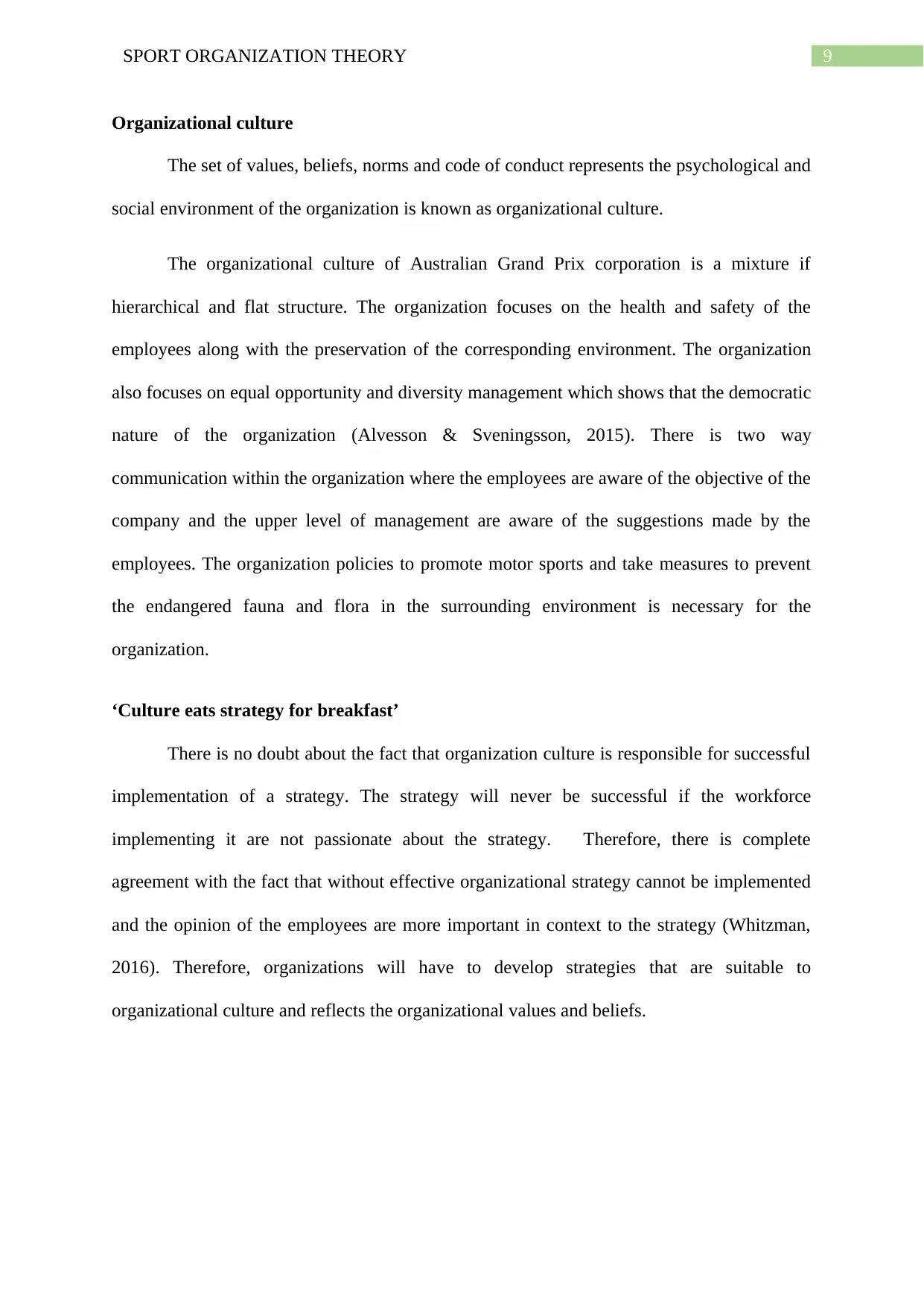
9SPORT ORGANIZATION THEORY
Organizational culture
The set of values, beliefs, norms and code of conduct represents the psychological and
social environment of the organization is known as organizational culture.
The organizational culture of Australian Grand Prix corporation is a mixture if
hierarchical and flat structure. The organization focuses on the health and safety of the
employees along with the preservation of the corresponding environment. The organization
also focuses on equal opportunity and diversity management which shows that the democratic
nature of the organization (Alvesson & Sveningsson, 2015). There is two way
communication within the organization where the employees are aware of the objective of the
company and the upper level of management are aware of the suggestions made by the
employees. The organization policies to promote motor sports and take measures to prevent
the endangered fauna and flora in the surrounding environment is necessary for the
organization.
‘Culture eats strategy for breakfast’
There is no doubt about the fact that organization culture is responsible for successful
implementation of a strategy. The strategy will never be successful if the workforce
implementing it are not passionate about the strategy. Therefore, there is complete
agreement with the fact that without effective organizational strategy cannot be implemented
and the opinion of the employees are more important in context to the strategy (Whitzman,
2016). Therefore, organizations will have to develop strategies that are suitable to
organizational culture and reflects the organizational values and beliefs.
Organizational culture
The set of values, beliefs, norms and code of conduct represents the psychological and
social environment of the organization is known as organizational culture.
The organizational culture of Australian Grand Prix corporation is a mixture if
hierarchical and flat structure. The organization focuses on the health and safety of the
employees along with the preservation of the corresponding environment. The organization
also focuses on equal opportunity and diversity management which shows that the democratic
nature of the organization (Alvesson & Sveningsson, 2015). There is two way
communication within the organization where the employees are aware of the objective of the
company and the upper level of management are aware of the suggestions made by the
employees. The organization policies to promote motor sports and take measures to prevent
the endangered fauna and flora in the surrounding environment is necessary for the
organization.
‘Culture eats strategy for breakfast’
There is no doubt about the fact that organization culture is responsible for successful
implementation of a strategy. The strategy will never be successful if the workforce
implementing it are not passionate about the strategy. Therefore, there is complete
agreement with the fact that without effective organizational strategy cannot be implemented
and the opinion of the employees are more important in context to the strategy (Whitzman,
2016). Therefore, organizations will have to develop strategies that are suitable to
organizational culture and reflects the organizational values and beliefs.
Paraphrase This Document
Need a fresh take? Get an instant paraphrase of this document with our AI Paraphraser
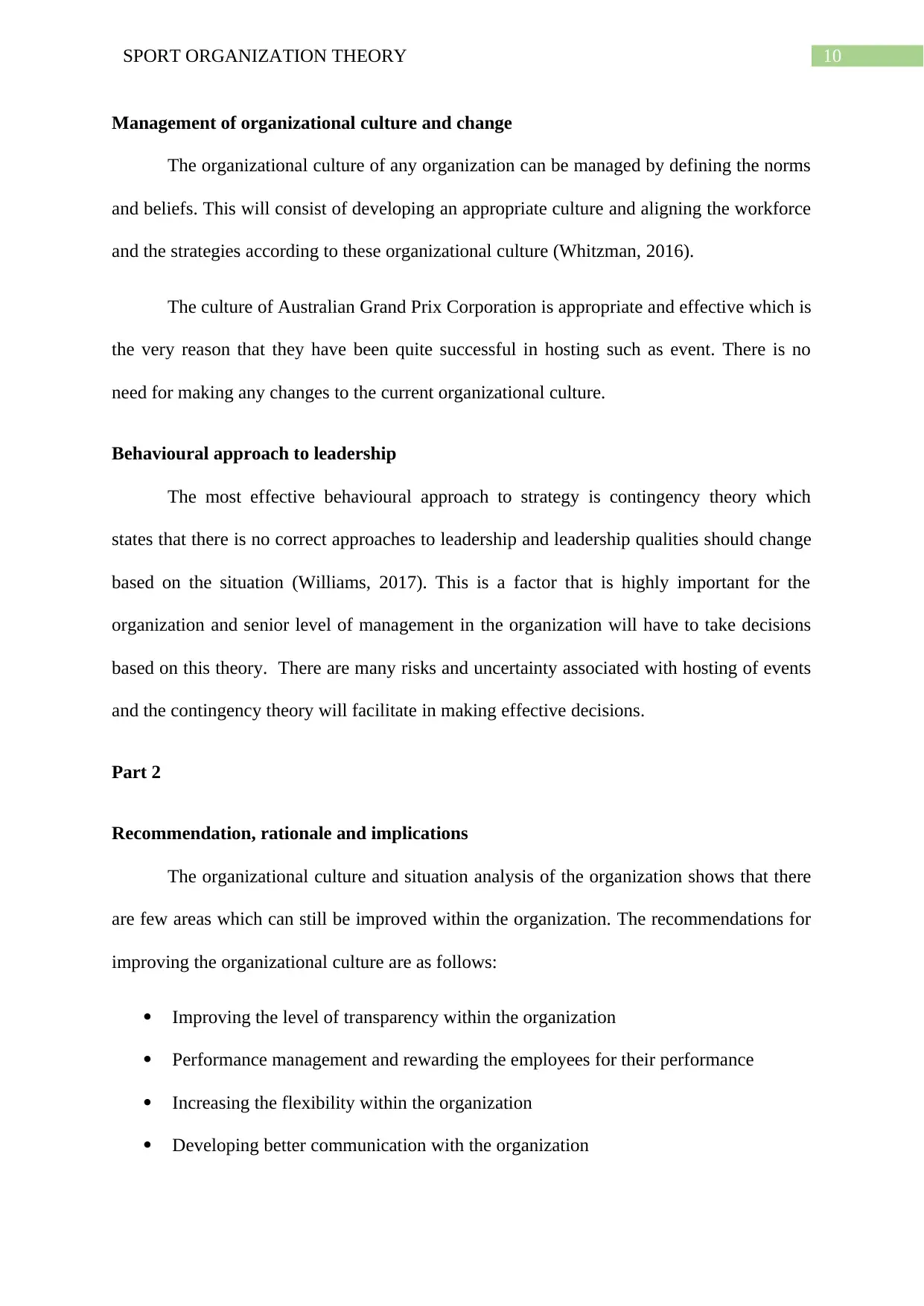
10SPORT ORGANIZATION THEORY
Management of organizational culture and change
The organizational culture of any organization can be managed by defining the norms
and beliefs. This will consist of developing an appropriate culture and aligning the workforce
and the strategies according to these organizational culture (Whitzman, 2016).
The culture of Australian Grand Prix Corporation is appropriate and effective which is
the very reason that they have been quite successful in hosting such as event. There is no
need for making any changes to the current organizational culture.
Behavioural approach to leadership
The most effective behavioural approach to strategy is contingency theory which
states that there is no correct approaches to leadership and leadership qualities should change
based on the situation (Williams, 2017). This is a factor that is highly important for the
organization and senior level of management in the organization will have to take decisions
based on this theory. There are many risks and uncertainty associated with hosting of events
and the contingency theory will facilitate in making effective decisions.
Part 2
Recommendation, rationale and implications
The organizational culture and situation analysis of the organization shows that there
are few areas which can still be improved within the organization. The recommendations for
improving the organizational culture are as follows:
Improving the level of transparency within the organization
Performance management and rewarding the employees for their performance
Increasing the flexibility within the organization
Developing better communication with the organization
Management of organizational culture and change
The organizational culture of any organization can be managed by defining the norms
and beliefs. This will consist of developing an appropriate culture and aligning the workforce
and the strategies according to these organizational culture (Whitzman, 2016).
The culture of Australian Grand Prix Corporation is appropriate and effective which is
the very reason that they have been quite successful in hosting such as event. There is no
need for making any changes to the current organizational culture.
Behavioural approach to leadership
The most effective behavioural approach to strategy is contingency theory which
states that there is no correct approaches to leadership and leadership qualities should change
based on the situation (Williams, 2017). This is a factor that is highly important for the
organization and senior level of management in the organization will have to take decisions
based on this theory. There are many risks and uncertainty associated with hosting of events
and the contingency theory will facilitate in making effective decisions.
Part 2
Recommendation, rationale and implications
The organizational culture and situation analysis of the organization shows that there
are few areas which can still be improved within the organization. The recommendations for
improving the organizational culture are as follows:
Improving the level of transparency within the organization
Performance management and rewarding the employees for their performance
Increasing the flexibility within the organization
Developing better communication with the organization
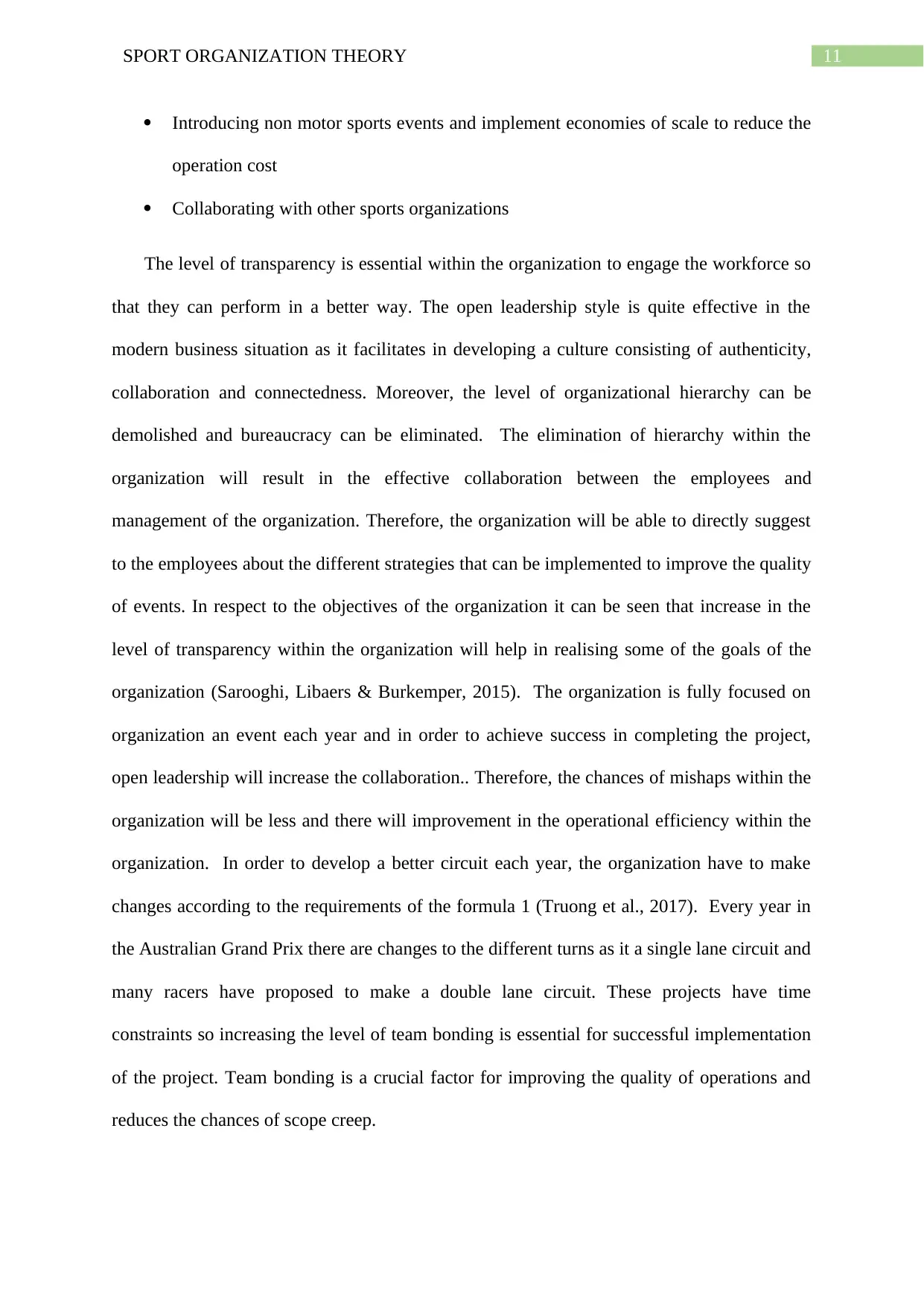
11SPORT ORGANIZATION THEORY
Introducing non motor sports events and implement economies of scale to reduce the
operation cost
Collaborating with other sports organizations
The level of transparency is essential within the organization to engage the workforce so
that they can perform in a better way. The open leadership style is quite effective in the
modern business situation as it facilitates in developing a culture consisting of authenticity,
collaboration and connectedness. Moreover, the level of organizational hierarchy can be
demolished and bureaucracy can be eliminated. The elimination of hierarchy within the
organization will result in the effective collaboration between the employees and
management of the organization. Therefore, the organization will be able to directly suggest
to the employees about the different strategies that can be implemented to improve the quality
of events. In respect to the objectives of the organization it can be seen that increase in the
level of transparency within the organization will help in realising some of the goals of the
organization (Sarooghi, Libaers & Burkemper, 2015). The organization is fully focused on
organization an event each year and in order to achieve success in completing the project,
open leadership will increase the collaboration.. Therefore, the chances of mishaps within the
organization will be less and there will improvement in the operational efficiency within the
organization. In order to develop a better circuit each year, the organization have to make
changes according to the requirements of the formula 1 (Truong et al., 2017). Every year in
the Australian Grand Prix there are changes to the different turns as it a single lane circuit and
many racers have proposed to make a double lane circuit. These projects have time
constraints so increasing the level of team bonding is essential for successful implementation
of the project. Team bonding is a crucial factor for improving the quality of operations and
reduces the chances of scope creep.
Introducing non motor sports events and implement economies of scale to reduce the
operation cost
Collaborating with other sports organizations
The level of transparency is essential within the organization to engage the workforce so
that they can perform in a better way. The open leadership style is quite effective in the
modern business situation as it facilitates in developing a culture consisting of authenticity,
collaboration and connectedness. Moreover, the level of organizational hierarchy can be
demolished and bureaucracy can be eliminated. The elimination of hierarchy within the
organization will result in the effective collaboration between the employees and
management of the organization. Therefore, the organization will be able to directly suggest
to the employees about the different strategies that can be implemented to improve the quality
of events. In respect to the objectives of the organization it can be seen that increase in the
level of transparency within the organization will help in realising some of the goals of the
organization (Sarooghi, Libaers & Burkemper, 2015). The organization is fully focused on
organization an event each year and in order to achieve success in completing the project,
open leadership will increase the collaboration.. Therefore, the chances of mishaps within the
organization will be less and there will improvement in the operational efficiency within the
organization. In order to develop a better circuit each year, the organization have to make
changes according to the requirements of the formula 1 (Truong et al., 2017). Every year in
the Australian Grand Prix there are changes to the different turns as it a single lane circuit and
many racers have proposed to make a double lane circuit. These projects have time
constraints so increasing the level of team bonding is essential for successful implementation
of the project. Team bonding is a crucial factor for improving the quality of operations and
reduces the chances of scope creep.
⊘ This is a preview!⊘
Do you want full access?
Subscribe today to unlock all pages.

Trusted by 1+ million students worldwide
1 out of 18
Related Documents
Your All-in-One AI-Powered Toolkit for Academic Success.
+13062052269
info@desklib.com
Available 24*7 on WhatsApp / Email
![[object Object]](/_next/static/media/star-bottom.7253800d.svg)
Unlock your academic potential
Copyright © 2020–2025 A2Z Services. All Rights Reserved. Developed and managed by ZUCOL.





